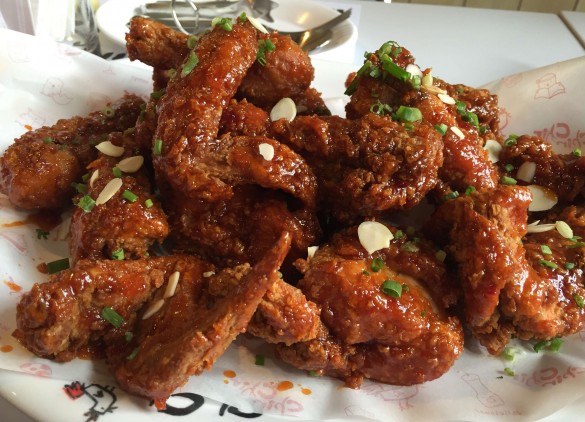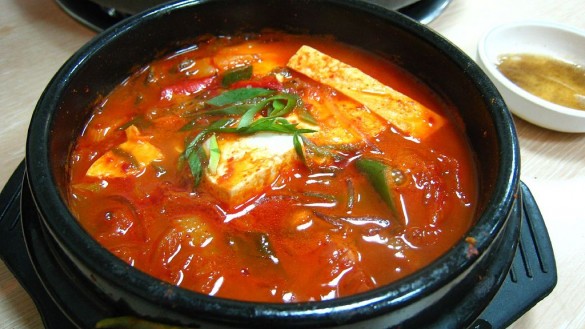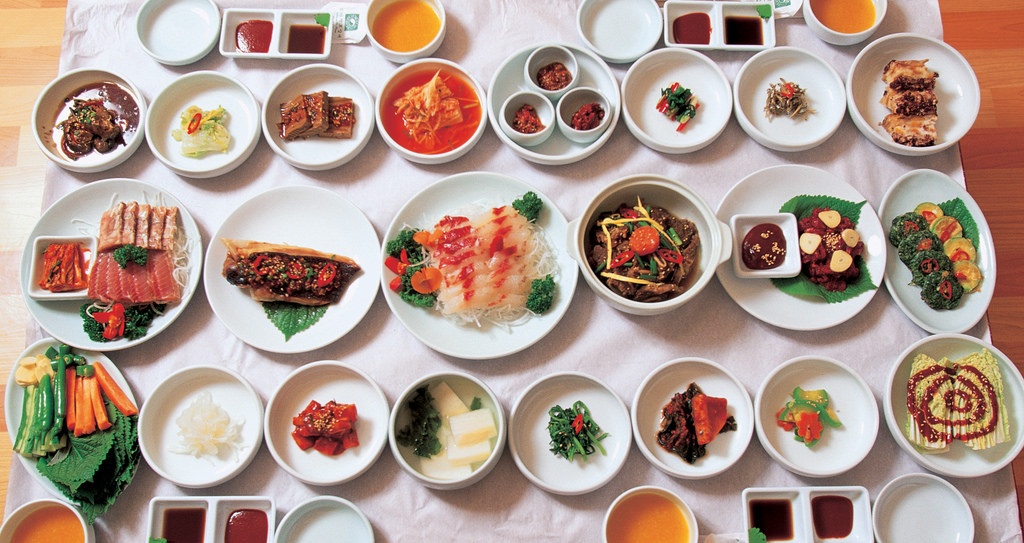As Korean food gains popularity worldwide, food writer May Tien explores the different facets of the cuisine and delves into the varied menu options available in Jakarta.
I can’t remember when I first had Korean food. It seems like one of the cuisines my family adopted into our culinary repertoire at a very early stage. My ancestors from my father’s side lived close to the border of the Korean peninsula in Shandong province. Perhaps my affinity for Korean food can be traced back to those early days when borders had not yet been drawn and passed generations through those Shandong genes.
Kkanpunggi, Korean-Chinese style fried chicken wings with a thin and crackly skin, super succulent meat and sweet-savoury-soy-garlic-based glaze was the first Korean dish that I can remember; most likely because it was the closest thing to a delicious meat lollipop to me. It translated well through to adulthood as I would endure two-hour long waits simply to sit at a table and place an order.

Nowadays, you can find hundreds of Korean fried chicken (the other more delicious KFC) fast food outlets around the world, most of them serving their own version of some of this fried goodness. Here in Jakarta, there are plenty of Korean fried chicken stops in the megamalls and the best ones allow you to pick and choose your sauces and toppings, bone-in or without. It is better than any Western-style fried chicken you have ever eaten – trust me on this one.
This article is not for the Korean foodie aficionado, but rather a primer for those who want a taste of something other than the typical KBBQ restaurant that has blown over in popularity. So down the rabbit hole of Korean cuisine we go, into a vast arena of varied foodstuffs and delectable findings that isn’t all about fermented cabbage and marinated beef.
Jigae and Tang/Guk (Stews and Soups)
Who doesn’t love a hearty stew or soup? In Korean cuisine, there’s one for every occasion, ailment and reason for being. It’s not a meal without a guk or tang present and most restaurants usually serve a single complementary serving with your meal. For the uninitiated, galbitang – a simple clear soup consisting of tender short ribs and daikon radish – is very satisfying and palate-cleansing. There is also the restorative samgyetang, an herb-infused chicken soup that utilizes a whole chicken stuffed with garlic, ginseng, scallions, jujubes and rice. Unsurprisingly, Koreans tend to eat this soup on the hottest days of the year to promote the body’s natural cooling system: sweating.
For those who love the spiciness of kimchi (like me), there’s a jigae loaded with it and served boiling hot in a ceramic bowl with some thin slices of pork or beef. One of my other favourites is the soon dubu jigae, which is fresh soft tofu stew – and usually served spicy enough to kick you in the rear end the next day. Best eaten with lots of steamed rice and chilled beer. These stews are extremely hearty and some require an iron stomach on account of the chilli pastes and kimchi with which it is cooked, but on a wet and dreary night, nothing beats a bubbling, lava-hot jigae with some steamed white rice.

Hwe (Korean Raw Fish)
The difference between Korean and Japanese style raw fish is all in the sauces and accompaniments that go with it. Japanese sashimi is a simple meal usually eaten with some pungent wasabi and shoyu, or Japanese soy sauce. The Koreans, on the other hand, love to spice their raw fish up with sauces such as chogochujang or ssamjang, which are somewhat similar chilli pastes mixed with a host of other seasonings and alliums. There is almost always a dip comprised of toasted sesame oil amplified with a big dash of salt. It is delicious on almost everything. Then, there are the accompanying perilla and lettuce leaves, sliced raw garlic and chilis, roasted seaweed, long strings of refreshing daikon radish. You eat the slices of raw fish in a spicy-savoury vegetable wrap.
The other major difference between hwe and sashimi is that hwe is served (preferably) fresh off the live fish.
Some restaurants serve fish slices that are still wriggling post-mortem, and tanks of fresh seafood are sometimes displayed in the dining room to show off just how fresh your hwe will be.
When you order hwe, you’re not just getting raw fish. You’re also getting soup made from the fish bones and banchan (complementary side dishes). And, many people enjoy their seafood feast with chilled beer or soju. Hite or OB, if you can find it in Jakarta, are common Korean beers served ice cold that are particularly good with this meal.
Guksu or Myeon (Korean noodles)
There is a staggering variety of noodles in Korean cuisine. Noodles made of sweet potato starch or pumpkin and wheat or acorn flour or buckwheat or dried corn flour. There are hot and dry noodles, cold and soupy noodles, cold and dry noodles, hot and soupy noodles, and stir-fried noodles.
I am partial to mul naengmyeon, which is a chilled and very refreshing bowl of chewy Korean-style buckwheat noodles (not the same as Japanese soba as the texture is much more a workout for your jaw) in a slightly sweet and sour beef broth accented with sliced pears and cucumbers with a top note of hot mustard. It might sound strange, but it is a unique taste and provides a perfect counterbalance to all of those hot, soupy noodles that might just be slightly off-putting during the unrelenting midday heat during dry season in Indonesia.

However, if spicy seafood soup noodles are your jam, then jjamppong is something one should consider from the menu. Jjamppong is one of those Korean-Chinese fusion dishes where the true origins are probably from a bit further west of the peninsula, but the current dish is a product of Korean innovation and ingredients. It’s a hodge-podge of various Korean vegetables, pork and seafood. It’s also quite spicy with the addition of gochugaru, a dried and fine chilli powder that is used quite extensively in the cuisine.
Korean Fried Chicken
Chir Chir Indonesia
Ruko Garden House B20
Pantai Indah Kapuk, North Jakarta
Instagram: @chirchirindonesia
Tel: 021 2903 3491
Bon Chon
Various outlets
Website: https://bonchon.com
Kyo Chon
Various outlets
Website: www.kyochon-indonesia.com/
Jigae and Tang/Guk
Mr. Park
Various locations
Twitter: Twitter.com/MrParkResto
Cheongdam Garden
Address: Jalan Senopati No. 43 C, Jakarta
Telephone: 021 521 2522
Hwe
Chunghae Soosan
Address: Jalan Senopati No. 49, Jakarta
Telephone: 021 527 8721
Kim Sat Gat
Address: Jalan Senayan No. 29, Jakarta
Telephone: 021 722 2230
Myeon/Guksu
Legend of Noodle
Address: Jalan Senopati No. 81, Jakarta
Telephone: 021 2188 9061 ext: 399
Jjang Korean Noodle and Grill
Address: Jalan Wolter Monginsidi No.39, (2nd floor of Kambing Bakar Kairo), Kebayoran Baru, South Jakarta
Telephone: 021 722 9749




